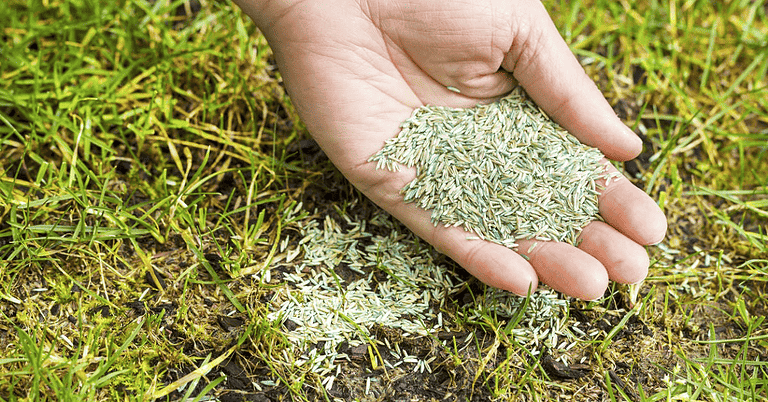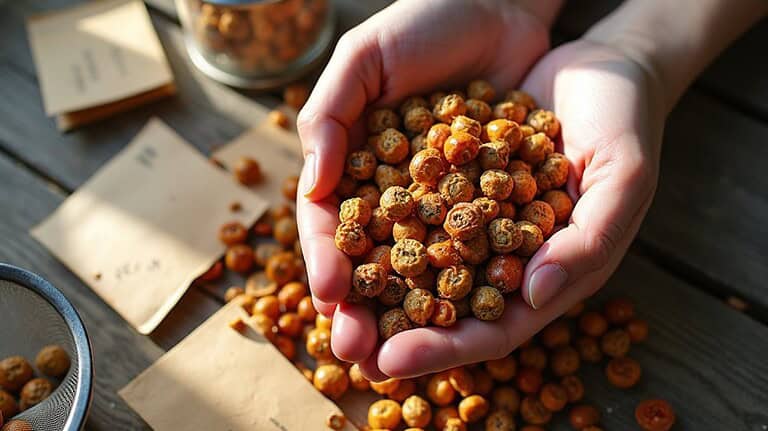When to Harvest Red Onions for Best Flavor
You’ll want to harvest your red onions for the absolute best flavor when about one-third of those green tops have turned that beautiful golden yellow and started flopping over like they’re taking a little nap – this usually happens around 95 days after planting from seed. The bulbs should feel firm and fist-sized with papery outer skins, and you’ll definitely want to time this during dry weather between 45°F and 55°F for ideal sweetness and storage potential that’ll make your future cooking escapades even more delicious.
TLDR
- Red onions reach peak flavor after 95 days from seed when one-third of leaves turn golden yellow.
- Harvest when stems soften and tops flop over, indicating the bulb has reached full maturity.
- Choose dry weather conditions with temperatures between 45°F-55°F to maximize flavor development and storage potential.
- Cure harvested onions for 2-4 weeks in a dry, ventilated space to enhance sweetness and flavor.
- Avoid wet harvesting conditions as moisture negatively affects both flavor quality and long-term storage capability.
Understanding Red Onion Growing Timeline and Maturity Windows
When you’re dreaming of those perfect, deep purple onions that’ll make your camping buddies weep tears of joy (and not just from the chopping!), understanding the growing timeline becomes your secret weapon for harvesting at peak flavor.
Red onions need roughly 95 days from seed to harvest, shifting through vegetative growth, bulbing, and potentially flowering phases that determine sweetness. During the crucial vegetative phase, each leaf that forms represents a ring on the future bulb, so preserving all foliage maximizes your onion’s final size and flavor potential. Additionally, starting your onions from seeds over sets can lead to larger bulbs and better overall health, contributing to that delicious flavor you desire.
Visual Signs That Signal Peak Harvest Readiness
The magic moment arrives when your red onions start broadcasting their readiness through a harmony of visual cues that’ll make any camping chef’s heart skip a beat!
Watch for one-third of leaves turning golden yellow, stems softening like cooked spaghetti, and tops flopping over dramatically. Proper soil preparation ensures that your onions have the best chance to thrive, making these signs even more rewarding. Those papery outer skins and fist-sized bulbs scream “harvest me now!” To ensure your bulbs develop the toughest protective skins for storage, stop watering your red onions 3 to 7 days before you plan to harvest them.
Weather Conditions That Maximize Harvest Success
Mother Nature’s got her own timeline for red onion harvests, and trust me, you’ll want to dance to her rhythm if you’re dreaming of those perfect, tear-inducing beauties for your next camping feast! Wait for dry weather windows, ideally when temperatures hover between 45°F and 55°F, because wet conditions absolutely wreck your onions’ flavor and storage potential. Additionally, keeping an eye on tank pressure can help ensure your cooking equipment remains operational during your outdoor culinary adventures.
Proper Techniques for Gentle Onion Removal
When it’s time to remove your red onions from the ground, you’ll want to approach this vital step with the same care you’d use when packing fragile camping gear for a backpacking trip – one wrong move and you might damage something you’ve worked hard to cultivate!
The secret lies in three key techniques: properly loosening the soil around each bulb without stabbing through it, using a gentle pulling motion that won’t snap the neck, and preventing bruises that’ll turn your beautiful harvest into a mushy disappointment faster than you can say “campfire onion rings.”
Trust me, I’ve learned the hard way that rushing this process is like trying to stuff a sleeping bag back into its sack without folding it properly – it just creates more problems down the road!
Soil Loosening Methods
Several effective soil loosening methods can make the difference between bruised, damaged onions and perfectly intact bulbs that’ll store beautifully for months – and trust me, after accidentally mangling half my first red onion harvest with a heavy garden fork, I’ve learned these techniques the hard way!
Water your bed thoroughly the day before harvesting, then use gentle hand forks or broadforks to carefully aerate the soil around your precious red onions without disturbing the bulbs directly.
Gentle Pulling Technique
The magic moment arrives when you’re finally ready to lift those gorgeous red onions from the earth, and just like pulling a tent stake from rocky campground soil, the technique you use makes all the difference between success and frustration!
Grasp each bulb firmly at its base, never yanking from the tops, then apply steady upward pressure while giving a gentle twist to coax those beauties free.
Damage Prevention Tips
Before you even think about grabbing those red onion bulbs with your bare hands, you’ll want to grab your trusty pitchfork or hand fork and start loosening the soil around each onion—trust me, this simple step will save you from turning your beautiful harvest into a bruised mess that looks like it went ten rounds with a grumpy badger!
Essential Curing Process for Maximum Flavor Development
Once you’ve gently lifted those beautiful red onions from the soil, you’ll need to give them the proper curing treatment they deserve – think of it like letting a fine cheese age to perfection, except your onions will be ready in just 2-4 weeks instead of months!
Setting up the right curing environment is absolutely essential for developing that sweet, mellow flavor that makes homegrown onions so much better than store-bought ones, and I’ve learned from experience that rushing this process will leave you with bland, short-lived bulbs that’ll disappoint you faster than a deflated camping air mattress.
You’ll want to create a dry, well-ventilated space where your onions can spread out without touching each other, because proper airflow around each bulb is what changes those sharp, tear-inducing layers into the sweet, storage-ready treasures you’re after.
Proper Curing Setup
After you’ve successfully harvested your red onions with their tops still attached, you’ll want to set up the perfect curing environment that’ll convert those freshly pulled bulbs into deeply flavorful gems with incredible storage potential.
Find a warm spot around 75-80°F with excellent airflow, like a shaded garage or covered porch, where gentle breezes can work their magic.
Duration and Storage
While you’re probably enthusiastic to start cooking with those gorgeous red onions right away, patience during the curing process will reward you with flavors that’ll make your taste buds do a happy dance around the campfire!
You’ll need 2-4 weeks for proper curing, then those beauties can stay fresh for 6 months to a year in cool, dark storage.
Storage Methods That Preserve Quality and Taste
Since you’ve worked so hard to harvest those beautiful red onions at their peak flavor, you’ll definitely want to store them properly so they maintain that incredible taste and don’t turn into sad, sprouted disappointments sitting in your kitchen!
Store them in cool, dark spaces around 45-55°F with good ventilation, using mesh bags instead of plastic.
How Full Maturation Impacts Sweetness and Flavor Profile
When your red onions reach full maturation, something magical happens in those underground bulbs that’ll make your taste buds dance with joy – the sugar content increases dramatically while those sharp, eye-watering sulfur compounds take a backseat!
You’ll notice the layers thicken beautifully, creating that perfect balance of mild pungency and natural sweetness that’s absolutely perfect for camping salads.
Common Timing Mistakes That Compromise Taste Quality
Now that you understand how incredible fully mature red onions taste, let’s talk about the sneaky timing mistakes that can turn your garden-fresh beauties into bland disappointments that’ll have you reaching for store-bought onions faster than you can say “camping disaster!”
You’d be shocked at how many fellow outdoor enthusiasts I’ve met who’ve accidentally sabotaged their own harvests by pulling their onions at the wrong moment – and trust me, I learned this lesson the hard way during a disastrous camping trip where my poorly-timed onion harvest left us with sharp, underdeveloped bulbs that made everyone’s eyes water instead of their mouths water.
Special Considerations for Flowering Onions and Quick Use
Although most gardeners dream of perfectly timed harvests with ideal storage-ready bulbs, you’ll inevitably encounter those rebellious red onions that decide to bolt and send up flower stalks.
Or maybe you’ll want to harvest some early as tender green onions for tonight’s campfire stir-fry – and here’s the thing that’ll save your culinary reputation around the campfire: these “off-schedule” onions aren’t garden failures, they’re just different tools in your outdoor cooking arsenal that require their own special handling techniques!
Overall
You’ve got this whole red onion harvesting thing down now, and honestly, there’s nothing quite like pulling those gorgeous, papery-skinned beauties from the soil at just the right moment! Whether you’re prepping for your next camping excursion or just want the sweetest onions for dinner tonight, timing really is everything – so watch those visual cues, cure them properly, and you’ll be rewarded with incredible flavor that’ll make every meal absolutely fantastic!






